Kayaking, Learning, and Exploring
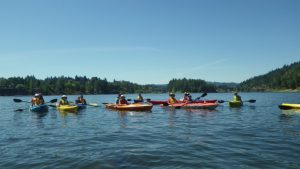
As summer heats up, heading to the water is a great way to cool down. Tryon Creek Watershed Council (TCWC) did just that on July 18 when we teamed up with Johnson Creek Watershed Council (JCWC) to co-lead an educational kayak tour along the Willamette River. Twenty participants joined us as we paddled from the mouth of Tryon Creek to the mouth of Johnson Creek (approx. 1.5 miles).
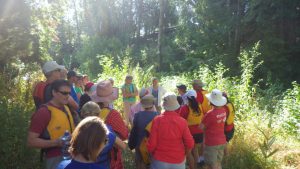
Before hitting the water, TCWC Coordinator Corrina Chase and Anne MacDonald from the City of Lake Oswego showed participants the restoration efforts at the mouth of Tryon Creek. They spoke to how restoration affects water quality, especially when it comes to erosion. Without native plants on stream banks to slow down stormwater, sediment can rush into creeks and increase the overall turbidity. When water becomes too turbid (cloudy), it becomes difficult for fish and other aquatic life to live.
After visiting Tryon, everyone launched their boats into the Willamette River and headed north to Johnson Creek, another urban watershed in the Portland Metro area. Danielle Miles, the Outreach & Volunteer Coordinator from JCWC, showed the major restoration project at the confluence of Johnson Creek and the Willamette. From 2011-2012, the area was heavily restored by constructing engineered log jams and placing boulders in two areas of exposed bedrock in the channel.
Fallen trees and rocks provide many important benefits to creeks, including slowing down water and creating diverse habitat for stream life. Without woody debris and rock, streams do not meander or curve but rather flow in a straight fashion. Water velocity will then increase because there are no bends or turns in the stream channel to slow water down. This leads to problems such as erosion. Logs and rocks also create pools for wildlife to hide from predators and provide areas for insects to lay eggs. Without these features in the stream channel, aquatic wildlife lose important areas to eat, reproduce, and protect themselves.
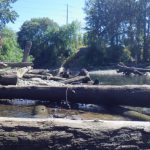
Engineered log jam on Johnson Creek 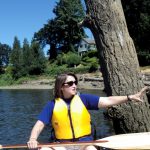
Danielle Miles, JCWC Outreach & Volunteer Coordinator
As Danielle explained these important benefits to our kayak group, an otter popped up from behind a log and swam around our boats – the perfect example of how beneficial this restoration project is for wildlife!
The kayak tour overall was a huge success. Everyone learned about how important restoring urban riparian habitat is to the overall health of our Oregon waterways. And what better way to appreciate them than to experience their beauty by the quiet, slow pace of a kayak?
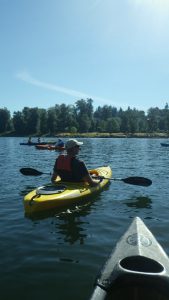
TCWC and JCWC had so much fun that we already have a kayak tour scheduled for next year on May 21, 2016 – registration and more details will be posted in early spring. Did you miss our tour? You can rent your own kayak at the mouth of Tryon Creek at the new Alder Creek Kayak boat house in Lake Oswego. Give them a call and they will be happy outfit you with kayaks, life jackets, and paddles. Go experience the amazing and beautiful Willamette watershed!


